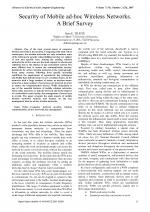| 2/2007 - 9 |
Security of Mobile ad-hoc Wireless Networks. A Brief SurveyTILIUTE, D. E. |
| Extra paper information in |
| Click to see author's profile in |
| Download PDF |
Author keywords
computer network security, wireless communication, ad-hoc networks, key management
References keywords
References keywords will be displayed on the next page reload.
About this article
Date of Publication: 2007-11-03
Volume 7, Issue 2, Year 2007, On page(s): 37 - 40
ISSN: 1582-7445, e-ISSN: 1844-7600
Digital Object Identifier: 10.4316/AECE.2007.02009
Web of Science Accession Number: 000259903400009
Abstract
One of the most present issues of computer wireless networks is the security. Comparing with their wired counterpart, the wireless networks not only accentuate some of the well-known security vulnerabilities but they are subject of new and specific ones. Among the existing wireless networks the ad hoc ones are the most exposed to attacks and collusions due to the absence of any centralized control. The most efficient way to ensure the communication secrecy, inclusively for ad hoc wireless networks, is the cryptography. From many reasons, following from specific operating conditions, the employment of asymmetric key techniques and Public Key Infrastructure is not a realistic choice. In the networks with a large number of nodes, as wireless sensor networks, a large number of secret keys are involved in order to ensure the communication secrecy. While dynamicity is one of the essential features of mobile wireless networks, when nodes may leave or join the network and in the absence of a centralized control entity, the management of secret keys is crucial. The paper presents the main aspects of mobile wireless networks security and focuses on the key management issue in ad-hoc wireless networks. |
| References | | | Cited By |
Web of Science® Times Cited: 5 [View]
View record in Web of Science® [View]
View Related Records® [View]
Updated 2 days, 1 hour
We were unable to retrieve information about this paper in SCOPUS®.
Message: [Returned results: 0]
[1] A Game-Theoretic Response Strategy for Coordinator Attack in Wireless Sensor Networks, Liu, Jianhua, Yue, Guangxue, Shen, Shigen, Shang, Huiliang, Li, Hongjie, The Scientific World Journal, ISSN 2356-6140, Issue , 2014.
Digital Object Identifier: 10.1155/2014/950618 [CrossRef]
[2] Rapid jamming detection approach based on fuzzy in WSN, Kanagasabapathy, Pradeep Mohan Kumar, Kedalu Poornachary, Vijayakumar, Murugan, Saravanan, Natesan, Arivazhagan, Ponnusamy, Vijayakumar, International Journal of Communication Systems, ISSN 1074-5351, Issue 2, Volume 35, 2022.
Digital Object Identifier: 10.1002/dac.4205 [CrossRef]
[3] Optimization between security and delay of quality-of-service, Chen, Jianyong, Zeng, Huawang, Hu, Cunying, Ji, Zhen, Journal of Network and Computer Applications, ISSN 1084-8045, Issue 2, Volume 34, 2011.
Digital Object Identifier: 10.1016/j.jnca.2010.11.012 [CrossRef]
[4] Considerations on VoIP Throughput in 802.11 Networks, POTORAC, A. D., Advances in Electrical and Computer Engineering, ISSN 1582-7445, Issue 3, Volume 9, 2009.
Digital Object Identifier: 10.4316/aece.2009.03009 [CrossRef] [Full text]
Disclaimer: All information displayed above was retrieved by using remote connections to respective databases. For the best user experience, we update all data by using background processes, and use caches in order to reduce the load on the servers we retrieve the information from. As we have no control on the availability of the database servers and sometimes the Internet connectivity may be affected, we do not guarantee the information is correct or complete. For the most accurate data, please always consult the database sites directly. Some external links require authentication or an institutional subscription.
Web of Science® is a registered trademark of Clarivate Analytics, Scopus® is a registered trademark of Elsevier B.V., other product names, company names, brand names, trademarks and logos are the property of their respective owners.
Faculty of Electrical Engineering and Computer Science
Stefan cel Mare University of Suceava, Romania
All rights reserved: Advances in Electrical and Computer Engineering is a registered trademark of the Stefan cel Mare University of Suceava. No part of this publication may be reproduced, stored in a retrieval system, photocopied, recorded or archived, without the written permission from the Editor. When authors submit their papers for publication, they agree that the copyright for their article be transferred to the Faculty of Electrical Engineering and Computer Science, Stefan cel Mare University of Suceava, Romania, if and only if the articles are accepted for publication. The copyright covers the exclusive rights to reproduce and distribute the article, including reprints and translations.
Permission for other use: The copyright owner's consent does not extend to copying for general distribution, for promotion, for creating new works, or for resale. Specific written permission must be obtained from the Editor for such copying. Direct linking to files hosted on this website is strictly prohibited.
Disclaimer: Whilst every effort is made by the publishers and editorial board to see that no inaccurate or misleading data, opinions or statements appear in this journal, they wish to make it clear that all information and opinions formulated in the articles, as well as linguistic accuracy, are the sole responsibility of the author.





